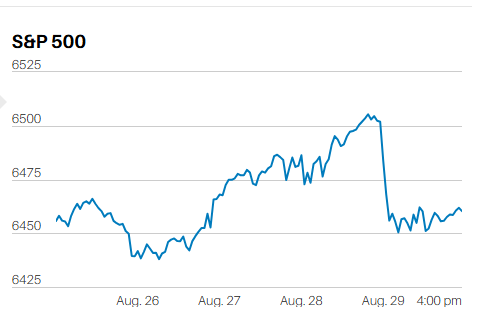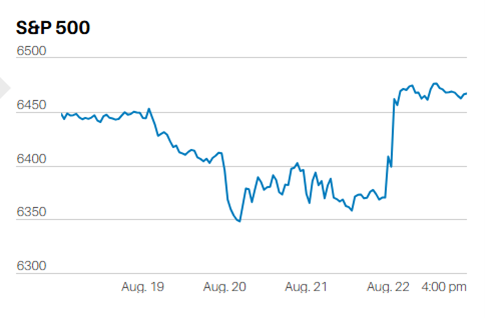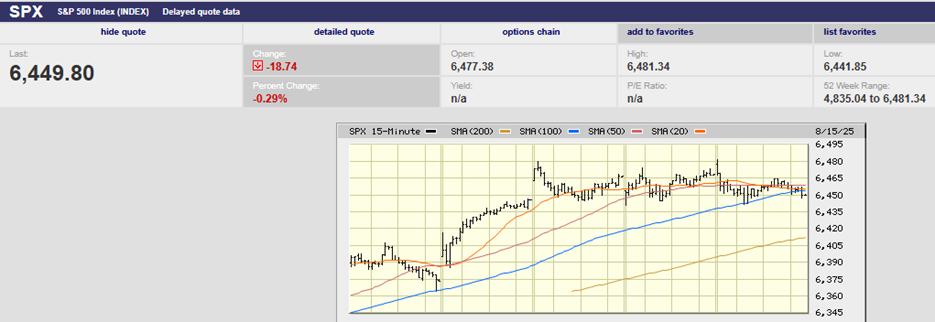Wall Street analysts are too optimistic

Market Update
The S&P 500 lost 1.6% last week, finishing Friday at 4348.87. It is its fifth decline in seven weeks. The Dow Jones Industrial index lost 1.9%. The Nasdaq fell 1.8%. The S&P is ripe for a test of the 4222.62 low hit on 24 January. The index dropped to 4327.22 Friday, it's low for the week. It started to rally in the afternoon but couldn't breach the 50-day moving average. The S&P spent the last hour of trading giving back much of the afternoon bounce. Last hour selling is smart money selling. In other words, professional money managers were limiting their exposure to the stock market over the long weekend. The S&P 500 may well test the 24 January low by week’s end.
Failure to hold the 24 January low at 4222.62 opens the index to further declines. It is already down 9.7% from the all-time high set 4 January. A 10% pullback is the common definition of a correction. There is support on either side of 4200. The S&P would likely hold that support, at least the first time it is tested.
It is not a monolithic market, however. Value stocks continue to do well while growth suffers. Energy stocks, dividend-paying stocks, and economically sensitive stocks are all doing well. The energy sector has outperformed the S&P 500 by almost 30% year-to-date. The technology sector has underperformed the S&P 500 by about 4%. The Russell 1000 value ETF has beaten the Russell 1000 Growth ETF by 10% so far in 2022.
Norwood Economics wrote frequently last year that value’s time was coming. Value outperforms growth over the long run. The extended run of growth outperformance was due to the extreme monetary policies of the Federal Reserve since the Great Recession. Those extreme monetary policies are coming to an end. Expect value to resume as the best performing investment style long-term. After all, value has beaten growth by 4.33% annually on average since 1926.
Also, expect more downside from the S&P 500. The index had three years in a row of double-digit advances. It has gone too far too fast. Earnings need time to catch up to price. Norwood Economics continues to forecast a flat to down market for 2022. We are still finding plenty of investable stocks, however. Good companies on sale that pay an above-average dividend. They are out there if you know where to look.
Economic Indicator
The producer price index was up 1% in January after rising 0.4% in December. The surge in producer prices indicates more inflation in the pipeline. Producer prices lead consumer prices higher. The Empire State manufacturing index was a weak 3.1 in February. It was -0.7 in January. New orders and shipments held steady. Unfilled orders increased while delivery times lengthened. The prices paid index remained near its peak. The prices received index reached a new record high. Firms expect conditions to improve over the next six months, according to the New York Fed. Although optimism dipped to its lowest level since mid-2020.
Retail sales rose a strong 3.8% in January after falling 2.5% in December. Industrial production rose 1.4% in January after falling 0.1% the prior month. The Philadelphia Fed manufacturing index was 16.0 in February down from 23.2 the prior month. The survey’s current indicators for general activity, new orders, and shipments declined from last month’s reading. Future indicators in the report show that firms expect growth over the next six months. The Conference Board’s leading economic indicators (LEI) index fell 0.3% in January after climbing 0.7% in December. The decline in the LEI was the first since last spring.
Overall, last week's economic indicators point to strengthening. It appears as if the economy is shrugging off the recent weakness caused by the omicron virus. The U.S. economy grew at a fast 6.9% rate in the fourth quarter of 2021. The Conference Board forecasts GDP growth of 2.2% in Q1 of 2022 and 3.5% for the year. The long-run sustainable growth rate for the U.S. is around 2.0%, which means 2022 economic growth is expected to remain above trend for now. Aggressive Fed monetary policy could slow the economy below trend by year-end, depending on the number of rate hikes in 2022.
Earnings Optimism
S&P 500 2022 earnings are expected to be around $225, up 8% from 2021. Forecast earnings for 2023 are 247.37 up 10.1% from 2022. The S&P is trading at 19.4x 2022 earnings and at 17.5x 2023 earnings. The S&P is trading at 18.9x twelve-month forward earnings. The twenty-year average for 12-month forward earnings is 18x and the longer-term average is 15.5x. The 2022 and 2023 earnings estimates are almost certainly too high. Earnings will be closer to $220 than $225 for 2022. Earnings will be closer to $234 than $247 for 2023. Twelve-month forward earnings are more likely to be around $218, putting the S&P at almost 20x earnings.
The haircut to earnings estimates is based on a McKinsey Group study. It found that analysts are overly optimistic. For instance, during a 25-year period ending in 2011, Wall Street analysts estimated yearly earnings growth at 10-12%. Actual earnings growth was 6%. The 6% earnings growth rate makes sense since that has also been the nominal growth rate of the economy. Earnings cannot grow faster than the economy over the long run. It isn’t mathematically possible. The McKenzie study noted that on average “analyst’s forecasts were almost 100% too high”.
The S&P 500 is likely trading at 20x 12-month forward earnings. The 20-year average is 18x and the longer-term average is 15.5x. The Federal Reserve is expected to tighten as much as seven times this year. The economy is also facing a fiscal cliff as massive spending plans wind down in 2022. Norwood Economics does not expect a recession or a bear market in 2022. We do believe the market will continue to struggle the rest of the year, however. Norwood Economics is underweight bonds but normal weight in stocks. It bears repeating: Norwood Economics is a normal weight in stocks. The stock market will do what it will do. Good companies on sale paying hefty dividends can still earn a good risk-adjusted return regardless.
Regards,
Christopher R Norwood, CFA
Chief Market Strategist











